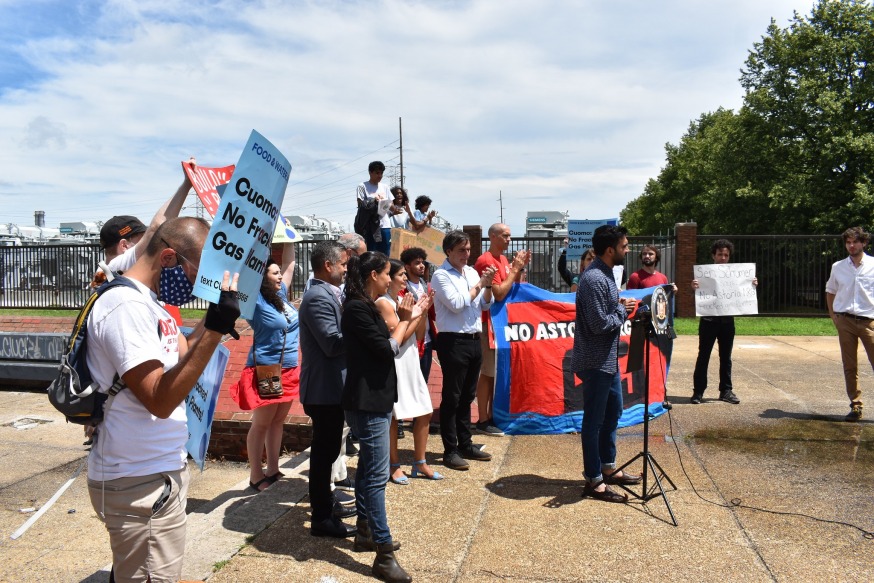
The NRG plant currently occupies 15 acres within the 300-acre Con-Edison complex in Astoria (NRG)
Oct. 28, 2021 By Allie Griffin
A number of renewable energy projects will be soon be coming online — negating the need for NRG’s proposed peaker plant that the state rejected earlier this week, according to several Queens leaders.
Local politicians said the state has no need for NRG’s proposal, which sought to overhaul the company’s 50-year-old peaker plant in Astoria by replacing its oil- and gas-fired turbines with a natural gas-fired generator.
The New York State Department of Environmental Conservation rejected NRG’s controversial application on Wednesday saying that it failed to comply with the requirements of the Climate Leadership and Community Protection Act, state legislation that places strict limits on emissions.
The existing NRG plant will be forced to close in May 2023, since it will no longer comply with state-level restrictions on nitrogen oxide emissions.
The loss of energy from the plant’s retirement — and other New York peaker plants slated to close at that time — will be made up by a number of Con Edison projects, according to the New York State Public Service Commission. The electric company is developing three transmission projects, collectively known as Transmission Reliability and Clean Energy Projects or TRACE projects, to make up for the energy loss.
The projects are designed to reduce pollutants in communities like Astoria where peaker power plants have affected nearby residents’ air quality for years. They aim to help New York transition to a cleaner, lower-carbon electric grid.
Former Astoria Council Member Costa Constantinides, a longtime environmental advocate, said it didn’t make sense for NRG to bring a fossil fuel-powered plant online when several clean energy projects are already in the works.
“We have all these great renewable projects coming,” Constantinides said. “Then we are going to open a fossil fuel plant. It just doesn’t fit.”
Constantinides named a number of projects that will soon be constructed like the Champlain Hudson project, which will be delivering 1,200 megawatts of green electricity from the U.S.-Canadian border to the Astoria Energy Complex starting in 2025.
He also said Equinor, a Norwegian energy giant, is developing an offshore wind farm that will transmit power under the Long Island Sound to a substation in Astoria. And Constantinides mentioned the potential to build and store renewable energy on Rikers Island via the Renewable Rikers Act, which he championed during his City Council tenure.
The DEC’s rejection of the plant was also applauded by lawmakers such as U.S. Sen. Chuck Schumer, Rep. Alexandria Ocasio-Cortez, State Senators Michael Gianaris and Jessica Ramos, Assembly Member Zohran Mamdani and Queens Borough President Donovan Richards among others.

State Sen. Michael Gianaris, U.S. Senator Charles Schumer, State Senator Jessica Ramos, Assembly Member Zohran Mamdani, and Tiffany Caban held a press conference in opposition to the proposed NRG power plant in Astoria this summer. (Courtesy: Office of State Sen. Gianaris)
Ocasio-Cortez called the state’s decision a major climate victory for the district.
“Earlier this year, fossil fuel co. NRG began to rush high-pollution, fracked-gas peaker plants into our community,” she posted on Twitter. “We organized all year against it while securing wind + solar projects. Today the plant was denied. When we mobilize, we win.”
Richards said Queens residents made it clear they didn’t want the proposed plant from the very beginning.
“Queens has been emphatic and clear from the beginning: NRG’s proposed power plant in Astoria is antithetical to our critically important mission to eliminate our city’s dependence on fossil fuels and build a future centered on clean, renewable energy,” he said in a statement.
“We applaud the New York State Department of Environmental Conservation for denying NRG’s permits and standing with the families of Astoria in opposition to this disastrous plan.”
NRG, however, said its proposal would have immediately reduced the amount of pollution emitted from the peaker plant. The company argued that the city cannot be powered by renewable energy sources alone — given current technology. NRG added that it would have been able to convert the revamped plant to green hydrogen in the future.
5 Comments







thanks alot of information
The announced transmission projects plus offshore wind are indeed good news for the people of NYC who will be able to breathe cleaner air as a result – once built. While these projects are only promises at this time, they might already changed the calculation for NRG. Perhaps they were about to announce withdrawing their plans for Astoria and all this DEC denial of permit is merely political theater to make us feel better about the political and administrative process? Either way, why would it be the state’s business to decide what is a worthwhile investment for private capital? I don’t get it: if we don’t have enough “clean” energy to serve our needs, we turn to dirty energy. NRG was willing to make an investment in dirty energy, but I don’t think they were lying that it would have replaced even dirtier energy. So where was the problem? Renewable advocates argue that any investment in fossil fuels creates a lock-in into a fossil-dominated future for more years to come. If that is true, then it paints a very weak picture of state power. I think that if New York succeeds with clean energy, NRG losing dollars on a “foolish” investment in a fossil plant that lays idle soon does not need to be our concern.
with three mile island closed which produced 16,000 approx mega watts, indian point power plant which produced 2000 mega watts and astoria power plant which produces approx 2500 mega watts I hope we aren’t left short. The champlain project seems to bring 1200 Mw. I dont know how much the windmill deal will bring but I know normally they dont make that much energy. I’m concerned we will be left in the dark. looking forward to the new ideas.
The best option is nuclear. The safety measures are waaaay better today than 1960’s. Fukushima was an old structure. One can of soda can supply the lifetime of one individual. It’s simply the best. This renewable talk is a pure dream that will be a nightmare. FRANCE is nearly entirely nuclear.
truth- I agree. many of the nuclear power plants that exist are from the 60s and 70s. Think about the technology advancements we have made since than. even if it just gets us through the next 60 years while we work on developing new technology.